Neil harbisson
Download as pptx, pdf1 like963 views
Neil Harbisson is completely colorblind but has developed an "eyeborg" device that allows him to perceive color as sound. The eyeborg, developed with Adam Montandon, uses a camera mounted on Harbisson's head to detect colors and translate them into specific musical pitches that Harbisson hears. Now Harbisson experiences the world through a unique combination of visual and auditory perception, saying "I receive color through the bone, and IÔÇÖm listening to you through the ears." His device has helped him appreciate color in new ways and sparked interest from other artists exploring color and sound.
1 of 27
Download to read offline
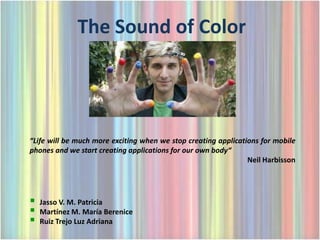
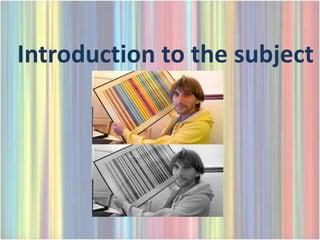

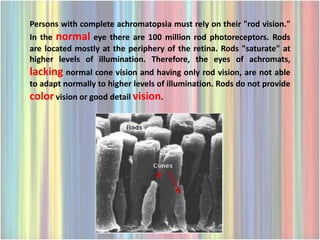
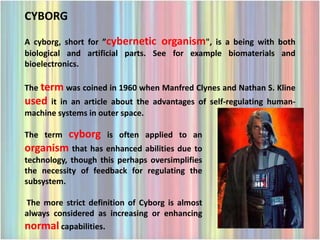
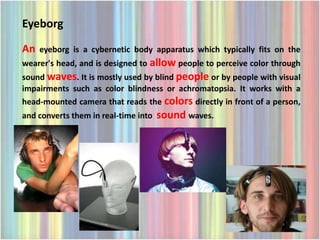
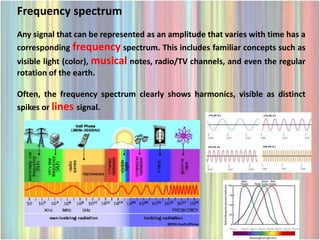
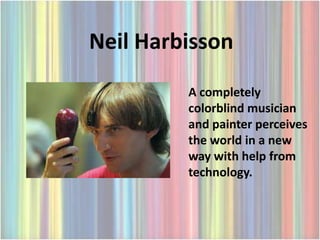
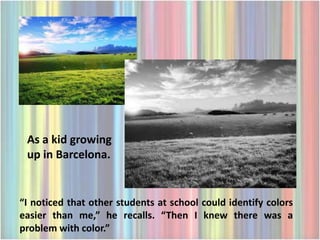
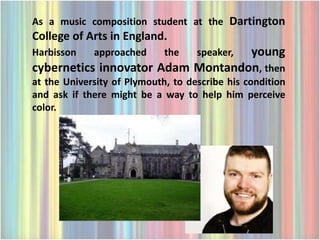
![Montandon then considered a device
that would simply say the names of
colors aloud, but this didnÔÇÖt sit right
with him either. ÔÇ£I wanted to give
him something a bit more magical,ÔÇØ
Montandon recalls. Finally, he
thought about the physical
similarities of light and sound. ÔÇ£Light
is a wavelength that moves very
fast,ÔÇØ he says. ÔÇ£[If] you slow it down
enough, it stops becoming visible. It
starts becoming audible.ÔÇØ](https://image.slidesharecdn.com/neilharbisson-121110142709-phpapp02/85/Neil-harbisson-11-320.jpg)
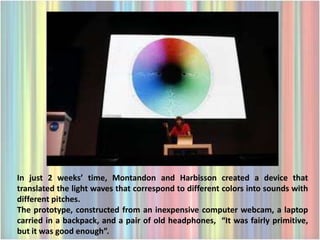
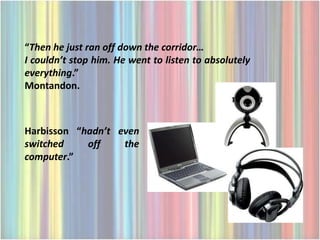
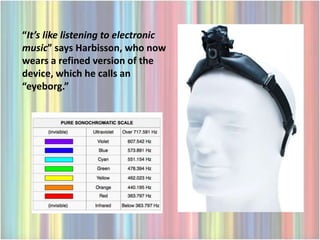

![Indeed, HarbissonÔÇÖs eyeborg
is catching the attention of
some musicians and artists.
The pianist Jools Holland, used a version of the device to
accompany live concerts held in 2009ÔÇô2010 across the U.K.
ÔÇ£He likes to improvise, [so] we created a reverse system that
would turn his music into colors and lights as he played.ÔÇØ](https://image.slidesharecdn.com/neilharbisson-121110142709-phpapp02/85/Neil-harbisson-16-320.jpg)
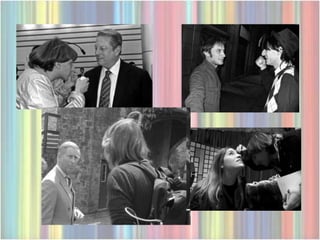
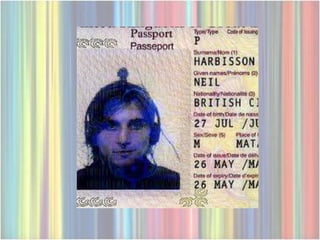

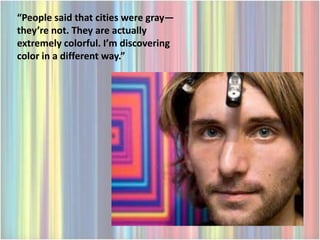
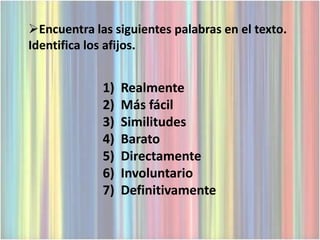

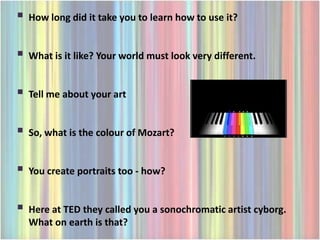
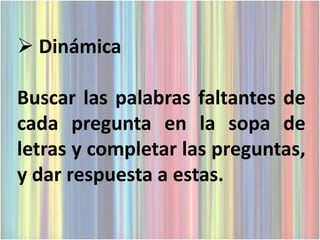
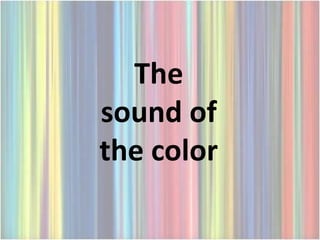

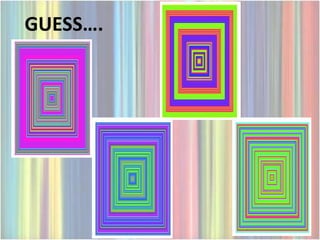
Ad
Recommended
Nouns and modifiers _John Pawson's ballet design
Nouns and modifiers _John Pawson's ballet designLeticia Portugal
╠²
The document discusses the dance performance 'Chroma' at the San Francisco Ballet, featuring a set designed by British minimalist architect John Pawson. It highlights the production's surprising chromatic variations achieved through lighting and costumes, as well as the details of the set's construction. The performance is touring North America, with modifications made from the original design for easier transport.Constructivism
ConstructivismLeticia Portugal
╠²
Chapter from "Concepts of Modern Art" edited by Nikolas Stangos, Thames & Hudson, Ltd, London, 1997.Connectors u12
Connectors u12Leticia Portugal
╠²
1. The problem of the informal market in Mexico has become more complex due to the difficulty in measuring a phenomenon estimated to have reached 20% of Mexico's economic activity.
2. The state will have to provide some form of worker compensation unless unemployment levels fall, so that the domestic market can revive.
3. Marx agrees with Keynes that saving may be greater than planned investment, which will lead to unemployment, however he stresses that this is a problem which results from capitalist behavior and the distribution of income.History of English Listening Quiz
History of English Listening QuizLeticia Portugal
╠²
The document discusses the history and evolution of the English language over time. It provides a video and quiz about the origins of English words from Latin, French and other languages. The quiz questions cover topics like the influence of the Romans, Shakespeare, the King James Bible, and the spread of English vocabulary through conquests, American culture, and the internet.Pre reading renzo piano
Pre reading renzo pianoLeticia Portugal
╠²
This document provides instructions for a reading comprehension activity about the biography of Italian architect Renzo Piano. It outlines objectives like familiarizing oneself with the text, determining the topic and organization, and identifying useful words. It describes strategies for previewing like looking at visual aids, recalling prior knowledge, and generating questions. It also explains techniques for skimming like identifying cognates, typographic changes, repetition, numbers, and useful words. Finally, it describes scanning the text quickly to find specific information like numbers and proper nouns.Verbs in English
Verbs in EnglishLeticia Portugal
╠²
This document discusses verbs in English and their conjugations and meanings. It begins by defining what a verb is and then discusses the main differences between English and Spanish verbs. It explains that English verbs have few inflections and only have two main tenses - past and present. It then categorizes the different types of verbs in English - regular verbs, irregular verbs, auxiliary verbs (be, do, have), and modal verbs (can, may, must). The rest of the document provides tables outlining the conjugations of different English verb tenses and aspects, including simple, continuous, and perfect forms in the present, past, and future. It also discusses conditional verb forms.Pre Reading with Renzo Piano
Pre Reading with Renzo PianoLeticia Portugal
╠²
The document outlines a reading comprehension class focused on Renzo Piano's biography from Wikipedia, emphasizing activities for pre-reading, previewing, skimming, and scanning the text. It aims to familiarize students with the material and develop skills such as identifying topics, text organization, and vocabulary building. Specific strategies include identifying cognates, typographic changes, repetition, numbers, and scanning for key information.Word Morphology + Reading Comprehension
Word Morphology + Reading ComprehensionLeticia Portugal
╠²
The document discusses the concept of nouns in English grammar, outlining their types, roles in sentences, and forms. It also delves into the cultural and historical significance of mosaics as a decorative art, mentioning their early examples and importance in Christian basilicas. Additionally, it covers reading comprehension strategies like skimming and scanning for effective information retrieval.Heteronyms: Words with different meanings
Heteronyms: Words with different meaningsLeticia Portugal
╠²
El documento explica el concepto de heter├│nimos, palabras que se escriben igual pero tienen diferentes pronunciaciones y significados. Se proporcionan consejos sobre c├│mo evitar confusiones al leer estas palabras, como familiarizarse con ellas y considerar el contexto. Tambi├®n se incluye un ejemplo ilustrativo y un ejercicio interactivo para poner en pr├íctica lo aprendido.Taking Notes: Fast and Easy
Taking Notes: Fast and EasyLeticia Portugal
╠²
Janet Echelman is an American artist known for her large-scale, dynamic sculptures that respond to environmental forces like wind and light, utilizing unexpected materials such as fishing nets. Her notable works, including 'her secret is patience' and 'water sky garden,' aim to transform urban spaces and foster community engagement. Echelman's innovative approach blends ancient craft techniques with modern technology, creating immersive public art that connects with the local identity.KEY READING AND VOCABULARY SKILLS
KEY READING AND VOCABULARY SKILLSLeticia Portugal
╠²
This document discusses reading keys and key skills for reading and vocabulary. It focuses on developing reading skills and vocabulary skills, which are important for comprehending written text. The document suggests reading keys can help improve reading and vocabulary abilities.Famous people game
Famous people gameLeticia Portugal
╠²
This document provides a game to learn about famous people from history and around the world. It includes 20 individuals and provides their name, nationality, profession, what they are famous for, and whether they are alive or dead. The people featured come from various backgrounds and occupations, including scientists, pilots, actors, singers, writers, politicians and more.Referencias Visuales del Artista: Leticia PortugalLeticia Portugal
╠²
El documento explora la intersecci├│n del arte interactivo, la fotograf├¡a y otras formas de expresi├│n como la m├║sica y la literatura, destacando obras y artistas que han fusionado tecnolog├¡a y creatividad a lo largo de la historia. Se menciona un variado conjunto de antecedentes que abarcan desde el arte lum├¡nico hasta el arte de tele presencia e interfaces de realidad mixta. Tambi├®n se incluyen referencias a influencias culturales y obras significativas en cinematograf├¡a y poes├¡a.Retrato y Fotograf├¡aLeticia Portugal
╠²
El documento examina la evolución del retrato a lo largo de la historia del arte, destacando su papel en la representación de la identidad y la subjetividad. Se abordan ejemplos desde la antigüedad hasta el arte contemporáneo, resaltando la interacción entre el artista y el sujeto retratado. Además, se presentan artistas modernos que desafían las nociones tradicionales del retrato, explorando temas emocionales y sociales.The Beatles
The BeatlesLeticia Portugal
╠²
The document discusses the significant cultural influence of The Beatles during the 1960s, particularly highlighting their impact on fashion, music, and social movements. It illustrates how Beatlemania fueled youth rebellion and contributed to the popularization of the hippie movement and various social ideologies. Additionally, it documents their lasting legacy and influence on subsequent generations, illustrating both the band's musical evolution and their activism after the group's breakup.Nouns and modifiers _ John Pawson design
Nouns and modifiers _ John Pawson designLeticia Portugal
╠²
This document provides information about the dance Chroma performed at the San Francisco Ballet. It discusses the minimalist set designed by British architect John Pawson and the surprising chromatic variations achieved through lighting, sets, and costumes that were nearly all white or flesh-toned. The author had a conversation with the technical director about Pawson's work and the production. The set features a sloping curvature of walls and is constructed of wood with stretched canvas. Costumes were dyed to match the skin tones of the dancers.Tallest Buildings in the World
Tallest Buildings in the WorldLeticia Portugal
╠²
The document discusses several ambitious architectural projects that were never realized, including TatlinÔÇÖs Tower, a modern symbol designed in 1917 for St. Petersburg, and the mile-high Illinois skyscraper proposed by Frank Lloyd Wright in 1956. Other mentioned concepts include the Beacon of Progress, the Ultima Tower, and the Hotel Attraction, each with unique designs and intended purposes. These visionary structures highlight the challenges of ambitious architecture and urban planning throughout history.Apple
AppleLeticia Portugal
╠²
I did not find any information in the given document about Stephen Wozniak's dog. The document is about Apple products like iPhone, iPad, iPod etc. and does not mention anything about Wozniak's dog.Collocations
CollocationsLeticia Portugal
╠²
The document discusses collocations, which are combinations of words that frequently occur together in English. It explains their significance in language learning and provides examples of verb, business, and adjective collocations. The document emphasizes that collocations cannot be translated literally and are essential for effective communication.Unidad2: Modificadores del Sustantivo (Adjetivos)Leticia Portugal
╠²
Explicaciones (en espa├▒ol), ejemplos y ejercicios (en ingl├®s) aplicable a la comprensi├│n de lectura.What to do with Unknown Words?
What to do with Unknown Words?Leticia Portugal
╠²
In this unit you will learn different strategies on how to deal with difficult or unfamiliar vocabulary. The unit comes from the book: "Grammar and the Meaning of Language for Economics and Accounting Students" edited by Ecnomics Faculty at UNAMUnidad 6: Los Adverbios como unidades adicionales de informaci├│nLeticia Portugal
╠²
Introducción al uso de adverbios como unidades adicionales de información. Ejemplos y ejercicios desde la comprensión de lectura. Contexto: temas de economía. Cláusulas Adjetivas (explicación y ejercicios) Leticia Portugal
╠²
Breve explicaci├│n de c├│mo funcionan las cl├íusulas adjetivas en la comprensi├│n de lectura en ingl├®s. El vocabulario es del ├írea de econom├¡a y contabilidad.Cl├íusulas Adjetivas (ejercicios)Leticia Portugal
╠²
Ejercicios para practicar la identificación y comprensión de las cláusulas adjetivas, a partir de textos del área de economía y contabilidad.Unidad1: Verbos, Tiempos y UsosLeticia Portugal
╠²
Explicaciones en espa├▒ol sobre el uso de los verbos en ingl├®s en referencia a la comprensi├│n de lectura.
Del libro "Grammar for Economic and Accounting Students" editado por la UNAM.
UVCWeek 2Class 1
UVCWeek 2Class 1Jennifer Burns
╠²
The document discusses visual perception and the collaborative function of the eye and brain in creating vision, emphasizing its cultural significance rather than just its biological mechanisms. It uses the example of the Mona Lisa and various interpretations by artists to illustrate how visual communication has developed. The text also critiques the common 'eye as a camera' analogy, highlighting the complex processes involved in how we perceive shapes, colors, and movements through the brain's interpretation of light intensity differences.T O K Perception
T O K Perceptiongwsis
╠²
The document discusses how human perception does not always accurately reflect reality. It provides examples of how different animals can perceive aspects of the electromagnetic spectrum that humans cannot, like kestrels seeing in ultraviolet and dolphins hearing a wider range of tones. The document also discusses optical illusions and effects that demonstrate how perception is influenced by expectations, context, and prior experiences rather than just directly sensing external stimuli.More Related Content
Viewers also liked (20)
Heteronyms: Words with different meanings
Heteronyms: Words with different meaningsLeticia Portugal
╠²
El documento explica el concepto de heter├│nimos, palabras que se escriben igual pero tienen diferentes pronunciaciones y significados. Se proporcionan consejos sobre c├│mo evitar confusiones al leer estas palabras, como familiarizarse con ellas y considerar el contexto. Tambi├®n se incluye un ejemplo ilustrativo y un ejercicio interactivo para poner en pr├íctica lo aprendido.Taking Notes: Fast and Easy
Taking Notes: Fast and EasyLeticia Portugal
╠²
Janet Echelman is an American artist known for her large-scale, dynamic sculptures that respond to environmental forces like wind and light, utilizing unexpected materials such as fishing nets. Her notable works, including 'her secret is patience' and 'water sky garden,' aim to transform urban spaces and foster community engagement. Echelman's innovative approach blends ancient craft techniques with modern technology, creating immersive public art that connects with the local identity.KEY READING AND VOCABULARY SKILLS
KEY READING AND VOCABULARY SKILLSLeticia Portugal
╠²
This document discusses reading keys and key skills for reading and vocabulary. It focuses on developing reading skills and vocabulary skills, which are important for comprehending written text. The document suggests reading keys can help improve reading and vocabulary abilities.Famous people game
Famous people gameLeticia Portugal
╠²
This document provides a game to learn about famous people from history and around the world. It includes 20 individuals and provides their name, nationality, profession, what they are famous for, and whether they are alive or dead. The people featured come from various backgrounds and occupations, including scientists, pilots, actors, singers, writers, politicians and more.Referencias Visuales del Artista: Leticia PortugalLeticia Portugal
╠²
El documento explora la intersecci├│n del arte interactivo, la fotograf├¡a y otras formas de expresi├│n como la m├║sica y la literatura, destacando obras y artistas que han fusionado tecnolog├¡a y creatividad a lo largo de la historia. Se menciona un variado conjunto de antecedentes que abarcan desde el arte lum├¡nico hasta el arte de tele presencia e interfaces de realidad mixta. Tambi├®n se incluyen referencias a influencias culturales y obras significativas en cinematograf├¡a y poes├¡a.Retrato y Fotograf├¡aLeticia Portugal
╠²
El documento examina la evolución del retrato a lo largo de la historia del arte, destacando su papel en la representación de la identidad y la subjetividad. Se abordan ejemplos desde la antigüedad hasta el arte contemporáneo, resaltando la interacción entre el artista y el sujeto retratado. Además, se presentan artistas modernos que desafían las nociones tradicionales del retrato, explorando temas emocionales y sociales.The Beatles
The BeatlesLeticia Portugal
╠²
The document discusses the significant cultural influence of The Beatles during the 1960s, particularly highlighting their impact on fashion, music, and social movements. It illustrates how Beatlemania fueled youth rebellion and contributed to the popularization of the hippie movement and various social ideologies. Additionally, it documents their lasting legacy and influence on subsequent generations, illustrating both the band's musical evolution and their activism after the group's breakup.Nouns and modifiers _ John Pawson design
Nouns and modifiers _ John Pawson designLeticia Portugal
╠²
This document provides information about the dance Chroma performed at the San Francisco Ballet. It discusses the minimalist set designed by British architect John Pawson and the surprising chromatic variations achieved through lighting, sets, and costumes that were nearly all white or flesh-toned. The author had a conversation with the technical director about Pawson's work and the production. The set features a sloping curvature of walls and is constructed of wood with stretched canvas. Costumes were dyed to match the skin tones of the dancers.Tallest Buildings in the World
Tallest Buildings in the WorldLeticia Portugal
╠²
The document discusses several ambitious architectural projects that were never realized, including TatlinÔÇÖs Tower, a modern symbol designed in 1917 for St. Petersburg, and the mile-high Illinois skyscraper proposed by Frank Lloyd Wright in 1956. Other mentioned concepts include the Beacon of Progress, the Ultima Tower, and the Hotel Attraction, each with unique designs and intended purposes. These visionary structures highlight the challenges of ambitious architecture and urban planning throughout history.Apple
AppleLeticia Portugal
╠²
I did not find any information in the given document about Stephen Wozniak's dog. The document is about Apple products like iPhone, iPad, iPod etc. and does not mention anything about Wozniak's dog.Collocations
CollocationsLeticia Portugal
╠²
The document discusses collocations, which are combinations of words that frequently occur together in English. It explains their significance in language learning and provides examples of verb, business, and adjective collocations. The document emphasizes that collocations cannot be translated literally and are essential for effective communication.Unidad2: Modificadores del Sustantivo (Adjetivos)Leticia Portugal
╠²
Explicaciones (en espa├▒ol), ejemplos y ejercicios (en ingl├®s) aplicable a la comprensi├│n de lectura.What to do with Unknown Words?
What to do with Unknown Words?Leticia Portugal
╠²
In this unit you will learn different strategies on how to deal with difficult or unfamiliar vocabulary. The unit comes from the book: "Grammar and the Meaning of Language for Economics and Accounting Students" edited by Ecnomics Faculty at UNAMUnidad 6: Los Adverbios como unidades adicionales de informaci├│nLeticia Portugal
╠²
Introducción al uso de adverbios como unidades adicionales de información. Ejemplos y ejercicios desde la comprensión de lectura. Contexto: temas de economía. Cláusulas Adjetivas (explicación y ejercicios) Leticia Portugal
╠²
Breve explicaci├│n de c├│mo funcionan las cl├íusulas adjetivas en la comprensi├│n de lectura en ingl├®s. El vocabulario es del ├írea de econom├¡a y contabilidad.Cl├íusulas Adjetivas (ejercicios)Leticia Portugal
╠²
Ejercicios para practicar la identificación y comprensión de las cláusulas adjetivas, a partir de textos del área de economía y contabilidad.Unidad1: Verbos, Tiempos y UsosLeticia Portugal
╠²
Explicaciones en espa├▒ol sobre el uso de los verbos en ingl├®s en referencia a la comprensi├│n de lectura.
Del libro "Grammar for Economic and Accounting Students" editado por la UNAM.
Similar to Neil harbisson (16)
UVCWeek 2Class 1
UVCWeek 2Class 1Jennifer Burns
╠²
The document discusses visual perception and the collaborative function of the eye and brain in creating vision, emphasizing its cultural significance rather than just its biological mechanisms. It uses the example of the Mona Lisa and various interpretations by artists to illustrate how visual communication has developed. The text also critiques the common 'eye as a camera' analogy, highlighting the complex processes involved in how we perceive shapes, colors, and movements through the brain's interpretation of light intensity differences.T O K Perception
T O K Perceptiongwsis
╠²
The document discusses how human perception does not always accurately reflect reality. It provides examples of how different animals can perceive aspects of the electromagnetic spectrum that humans cannot, like kestrels seeing in ultraviolet and dolphins hearing a wider range of tones. The document also discusses optical illusions and effects that demonstrate how perception is influenced by expectations, context, and prior experiences rather than just directly sensing external stimuli.Matt Jones: The Robot-Readable World (Webdagene 2011)
Matt Jones: The Robot-Readable World (Webdagene 2011)webdagene
╠²
The document discusses the concept of a "robot-readable world" where fractional artificial intelligence, cheap maths, and cameras allow robots to understand the visual world. It presents examples of projects like FaceOSC and Sensor-Vernacula that aim to make things machine-readable. The document argues that "living in the middle" between humans and robots will be a strange experience that designers can help make more understandable and enjoyable for people.Tuesday With Morrie Essay.pdf
Tuesday With Morrie Essay.pdfJessica Gutierrez
╠²
The document discusses the challenges and opportunities of writing an essay about 'Tuesdays with Morrie,' focusing on the need to balance personal reflections with critical analysis of Morrie's life lessons on themes such as love, death, and meaning. It highlights the importance of engaging deeply with Morrie's teachings while navigating the emotional complexities of his battle with ALS, ensuring that the essay reflects thoughtful analysis rather than mere summarization. Ultimately, the document emphasizes capturing the essence of Morrie's wisdom and providing a fresh perspective on the narrative's broader implications.Sense Perception
Sense Perceptionalgrant
╠²
Our perception is influenced by expectations, language, and interpretation. We adjust how we perceive things and use context to resolve ambiguity. However, perception is limited by our biology and neurobiology. For example, we cannot perceive things that happen very fast or slow, or we may have conditions like visual agnosia that limit recognition.Timbre Essay
Timbre EssayTracy Huang
╠²
Timbre allows listeners to distinguish between different sounds and songs. It enables recognition of individual voices and notes in a piece of music. The song "Imagine" by John Lennon has strong timbre that makes it very recognizable. Different instruments like piano, drums, and violins contribute different types of timbre to the song.Lecture 3 a psychoacoustics of discriminating and identifying sounds
Lecture 3 a psychoacoustics of discriminating and identifying soundsIsra Institute of Rehab Sciences (IIRS), Isra University
╠²
Psychoacoustics is the study of how humans perceive and process sound. It examines our psychological and physiological responses to music and sound. Psychoacoustics looks at how we listen and dissects the listening experience, studying factors like how we perceive sound events, identify tones and patterns, and distinguish timbre. It also considers our memory-based reactions and physiological responses to different sounds. Psychoacoustics has become invaluable in designing technologies like hearing aids and cochlear implants by providing a better understanding of normal hearing function.el payaso a traves de la historia y como se fabricaban en la antiguedad.pdf
el payaso a traves de la historia y como se fabricaban en la antiguedad.pdfAlanGabrielPaucarCon
╠²
The document summarizes a performance by Carlo M├┤, a clown with no legs who uses crutches. The performance is a journey of discovery as he adapts to his new physical state and searches for ways to overcome physical and emotional disabilities, turning solutions into creative acts. It provides technical details needed to host the performance.Augmented reality: what and how
Augmented reality: what and howDamiano Lotto
╠²
The document discusses augmented reality, defining it as relating virtual environments to real environments to improve people's interaction with the real world by providing information not directly perceptible to the senses. It notes that for augmented reality to work properly, the real camera perspective must be precisely mapped to the virtual environment. The document explores using augmented reality to provide "contents" to museums by giving voice to cultural heritage exhibits through interactive links and references that highlight context and relationships. However, it notes that technology can be fragile and aims to inspire wonder over providing strict information.Interesting2007
Interesting2007Matt Jones
╠²
This document summarizes Warren Ellis's presentation titled "Global Frequency". The presentation touches on several topics in a loosely connected way, including urbanization, digital technology, play, parkour, augmented senses, and scale. It discusses how cities are becoming "slow computers" and how technology can help people project into larger contexts by considering things at different scales or through simulation. The presentation provides examples and perspectives on how technology might augment human senses and abilities in the future.Chamber Music Extension Paper: COM 495
Chamber Music Extension Paper: COM 495Rachel Rainville
╠²
The document discusses Flusser's concept of a "telematics society" where people share information through technology to create a "super brain." Flusser acknowledges that his previous works focused on verbs and processes, while Chamber Music represents a finished product of those actions. Flusser believes catastrophes cannot be predicted or avoided, but forecasting helps reduce damage from events like hurricanes. A telematics society could predict events to avoid catastrophes. The document also examines how chamber music and technology allow for continuous creation and sharing of information in an endless dialogue.ARE 494 final power point Chrystalee Begody
ARE 494 final power point Chrystalee BegodyChrystalee Begody
╠²
The document provides definitions and context for key terms related to digital ethnography research conducted in Second Life. It summarizes interviews with the creator of the Dryland region in Second Life, Anita Witt, an artist who exhibited work there named Pallina60 Loon, and a visitor to Dryland named Quiyote. The interviews covered topics like their real identities, art backgrounds, and responses to art criticism questions about Pallina60 Loon's installation "Woops...A Baby." The document also provides context on the real-world inspiration for Dryland and compares the three interviews.Ad training fractured u.-new
Ad training fractured u.-newjsnyder42
╠²
This document provides an overview for an audio description course. The course will be taught over 12 sessions by Joel Snyder and will cover the history and practice of audio description. Students will learn how to observe details, edit descriptions, use descriptive language, and practice audio describing live performances, films, art exhibits, and web content. The goal is for students to learn audio description skills and techniques to make visual media accessible for blind or low-vision people.Through the Lens
Through the Lensgpdept
╠²
Through the artistic lens, Steve Jobs discussed how great artists steal ideas and the people who worked on the Macintosh were from diverse backgrounds like music, poetry, art, zoology and history. A company called THIS aims to market the miswak tooth-cleaning twig from the Middle East as a biodegradable toothbrush and toothpaste alternative. Curved screens are a more natural medium for viewing content as they compensate for human visual distortion, similar to how the Parthenon appears straight from a distance due to optical illusion.Autonomous robots that paint
Autonomous robots that paintTev Tlov
╠²
This article discusses autonomous robots that create art. It describes two robotic artists, Max Chandler and Leonel Moura, who have created robots capable of painting autonomously. Chandler's robots paint using a top-down approach with his close involvement, while Moura's robots use a bottom-up swarm intelligence approach where the robots interact indirectly using chemical signals similar to ants. The article argues the art created by these robots is truly original and creative, as the robots incorporate new information through their interactions in a way similar to surrealist automatism art.Review of "The Shallows"
Review of "The Shallows"Daksha Bhat
╠²
This document summarizes a 224 page book. It discusses how the internet and computers are changing the way people read and think. It argues that constant partial attention and skimming of information online is rewiring our brains and harming our ability to focus deeply and think critically. While technology has enhanced and extended our minds, it also risks "flattening" our intelligence and making us more shallow thinkers if we rely too much on computers to store and process information for us.Lecture 3 a psychoacoustics of discriminating and identifying sounds
Lecture 3 a psychoacoustics of discriminating and identifying soundsIsra Institute of Rehab Sciences (IIRS), Isra University
╠²
Ad
More from Leticia Portugal (13)
Unidad10: PRONOMBRES Y REFERENTESLeticia Portugal
╠²
Explicaci├│n y ejemplos de los pronombres m├ís importantes para la comprensi├│n de textos en ingl├®s. Incluye varios ejercicios a partir de textos de negocios. Consolidation 4 interm
Consolidation 4 intermLeticia Portugal
╠²
The document consists of various exercises aimed at improving English language proficiency, focusing on grammar, vocabulary, and sentence construction. It includes activities such as filling in blanks, rephrasing sentences, correcting errors, and understanding phrasal verbs. Overall, it serves as a comprehensive resource for language practice and refinement.Connecting ideas in a sentence and between sentences
Connecting ideas in a sentence and between sentencesLeticia Portugal
╠²
Words and phrases used to connect ideas between sentences. Great explanation and exercises. Idioms and Colloquialisms1
Idioms and Colloquialisms1Leticia Portugal
╠²
The document discusses idioms and colloquialisms commonly encountered in TOEFL listening comprehension, emphasizing the need to learn these expressions individually. It contains several exercises where users must fill in dialogues with appropriate idioms and colloquial phrases. The goal is to enhance understanding and usage of these expressions in context.AffixesLeticia Portugal
╠²
Lista b├ísica de afijos: prefijos y sufijos en el idioma ingl├®s.
Estrategia básica para comprender el significado de las palabras desconocidas, sin recurrir al diccionario.
Morfología de la palabra. Word groups
Word groupsLeticia Portugal
╠²
The document discusses word groups and how to identify them. Word groups are words related to the same theme or idea. Examples are provided of word groups related to subjects in school, types of flowers, car makers, and types of weather. The document encourages reading for words connected by theme and underlining them to identify the theme the words relate to.Welcoming a visitor boardgame
Welcoming a visitor boardgameLeticia Portugal
╠²
The document provides a guide on how to engage with a visitor to your company by suggesting a series of introductory and conversational questions. It emphasizes introducing oneself, making small talk about various topics such as home towns, travel, and hobbies, and then properly concluding the meeting. The content is designed for practice in a language learning context.Talk about-it present perfect
Talk about-it present perfectLeticia Portugal
╠²
The document outlines the rules for a board game focused on using the present perfect tense in conversation. Players take turns throwing dice to advance on a board and engage in discussions based on topics related to their personal experiences. The objective is to be the first to reach the finish line by successfully discussing various prompts or answering questions about experiences in the present perfect tense.Superlative board-game
Superlative board-gameLeticia Portugal
╠²
The document outlines a board game that utilizes superlatives as prompts for players to discuss their personal experiences for 30 seconds. Players take turns rolling dice and advancing on a board while sharing related anecdotes, with penalties for not completing their turn. The goal is to reach the 'finish' square first to win the game.Phrasal verbs
Phrasal verbsLeticia Portugal
╠²
This document provides examples of common phrasal verbs used in English. It gives sample sentences demonstrating the phrasal verbs "get in/get on", "turn on/turn off", "get off/get out of", "give sb a call/call up", and "put on/take off". The phrasal verbs relate to entering or exiting vehicles, operating devices, making phone calls, and putting on or removing clothing.Memorizing glossaries
Memorizing glossariesLeticia Portugal
╠²
This document provides techniques for memorizing glossaries and terms from documents. It suggests organizing terms by their morphology like nouns ending in "ity" or verbs ending in "ing". Terms can also be organized in spidergrams by their meanings or relationships. Pictures and mental images can also be used to help recall terms. Word associations are another suggested memorization technique. The document encourages readers to practice these techniques by selecting a text, making a glossary from it, organizing the glossary, and then memorizing the terms.Verbs
VerbsLeticia Portugal
╠²
The document discusses verbs and their usage, tenses, and meanings. It notes that verbs tell what the subject does or is. Verbs can be single words or phrases. It also discusses different verb forms, including the infinitive with "to", gerunds formed with "-ing", and participles formed with "-ed". Verbs are identified in examples and their functions are explained. The document encourages practicing verb identification and analysis in other texts.Dictionary use
Dictionary useLeticia Portugal
╠²
This document provides guidance on using a dictionary to understand English texts. It contains exercises on looking up words in dictionaries, identifying parts of speech, recognizing guide words, completing verb charts, and translating phrases. It emphasizes that understanding the overall context clues and using resources like dictionaries can help infer the meaning of unknown words.Ad
Neil harbisson
- 1. The Sound of Color ÔÇ£Life will be much more exciting when we stop creating applications for mobile phones and we start creating applications for our own bodyÔÇ£ Neil Harbisson ´éº Jasso V. M. Patricia ´éº Mart├¡nez M. Mar├¡a Berenice ´éº Ruiz Trejo Luz Adriana
- 2. Introduction to the subject
- 3. What Is Achromatopsia? Congenital achromatopsia is a rare hereditary vision disorder which affects 1 person in 33,000 in the U. S. Persons who have achromatopsia do not have normal "cone vision." In the retinas of normal eyes there are 6 million cone photoreceptors, located mostly at the center of the retina. There are complete and incomplete forms of achromatopsia.
- 4. Persons with complete achromatopsia must rely on their "rod vision." In the normal eye there are 100 million rod photoreceptors. Rods are located mostly at the periphery of the retina. Rods "saturate" at higher levels of illumination. Therefore, the eyes of achromats, lacking normal cone vision and having only rod vision, are not able to adapt normally to higher levels of illumination. Rods do not provide color vision or good detail vision.
- 5. CYBORG A cyborg, short for ÔÇØcybernetic organism", is a being with both biological and artificial parts. See for example biomaterials and bioelectronics. The term was coined in 1960 when Manfred Clynes and Nathan S. Kline used it in an article about the advantages of self-regulating human- machine systems in outer space. The termcyborg is often applied to an organism that has enhanced abilities due to technology, though this perhaps oversimplifies the necessity of feedback for regulating the subsystem. The more strict definition of Cyborg is almost always considered as increasing or enhancing normal capabilities.
- 6. Eyeborg An eyeborg is a cybernetic body apparatus which typically fits on the wearer's head, and is designed to allow people to perceive color through sound waves. It is mostly used by blind people or by people with visual impairments such as color blindness or achromatopsia. It works with a head-mounted camera that reads the colors directly in front of a person, and converts them in real-time into sound waves.
- 7. Frequency spectrum Any signal that can be represented as an amplitude that varies with time has a corresponding frequency spectrum. This includes familiar concepts such as visible light (color), musical notes, radio/TV channels, and even the regular rotation of the earth. Often, the frequency spectrum clearly shows harmonics, visible as distinct spikes or lines signal.
- 8. Neil Harbisson A completely colorblind musician and painter perceives the world in a new way with help from technology.
- 9. As a kid growing up in Barcelona. ÔÇ£I noticed that other students at school could identify colors easier than me,ÔÇØ he recalls. ÔÇ£Then I knew there was a problem with color.ÔÇØ
- 10. As a music composition student at the Dartington College of Arts in England. Harbisson approached the young speaker, cybernetics innovator Adam Montandon, then at the University of Plymouth, to describe his condition and ask if there might be a way to help him perceive color.
- 11. Montandon then considered a device that would simply say the names of colors aloud, but this didnÔÇÖt sit right with him either. ÔÇ£I wanted to give him something a bit more magical,ÔÇØ Montandon recalls. Finally, he thought about the physical similarities of light and sound. ÔÇ£Light is a wavelength that moves very fast,ÔÇØ he says. ÔÇ£[If] you slow it down enough, it stops becoming visible. It starts becoming audible.ÔÇØ
- 12. In just 2 weeksÔÇÖ time, Montandon and Harbisson created a device that translated the light waves that correspond to different colors into sounds with different pitches. The prototype, constructed from an inexpensive computer webcam, a laptop carried in a backpack, and a pair of old headphones, ÔÇ£It was fairly primitive, but it was good enoughÔÇØ.
- 13. Then he just ran off down the corridor I couldnt stop him. He went to listen to absolutely everything. Montandon. Harbisson hadnt even switched off the computer.
- 14. ÔÇ£ItÔÇÖs like listening to electronic musicÔÇØ says Harbisson, who now wears a refined version of the device, which he calls an ÔÇ£eyeborg.ÔÇØ
- 15. Today, the system comprises a camera that sticks out above HarbissonÔÇÖs head like an antenna, and a small computer chip that converts light to sound. . ÔÇ£I receive color through the bone, and IÔÇÖm listening to you through the earsÔÇØ Harbisson says.
- 16. Indeed, HarbissonÔÇÖs eyeborg is catching the attention of some musicians and artists. The pianist Jools Holland, used a version of the device to accompany live concerts held in 2009ÔÇô2010 across the U.K. ÔÇ£He likes to improvise, [so] we created a reverse system that would turn his music into colors and lights as he played.ÔÇØ
- 20. ÔÇ£People said that cities were grayÔÇö theyÔÇÖre not. They are actually extremely colorful. IÔÇÖm discovering color in a different way.ÔÇØ
- 21. ´âÿEncuentra las siguientes palabras en el texto. Identifica los afijos. 1) Realmente 2) M├ís f├ícil 3) Similitudes 4) Barato 5) Directamente 6) Involuntario 7) Definitivamente
- 23. ´éº How long did it take you to learn how to use it? ´éº What is it like? Your world must look very different. ´éº Tell me about your art ´éº So, what is the colour of Mozart? ´éº You create portraits too - how? ´éº Here at TED they called you a sonochromatic artist cyborg. What on earth is that?
- 24. ´âÿ Din├ímica Buscar las palabras faltantes de cada pregunta en la sopa de letras y completar las preguntas, y dar respuesta a estas.
- 26. ´âÿ Din├ímica ┬┐a qu├® te suenan las siguientes im├ígenes???
- 27. │Ê▒½Àí│º│ºÔǪ.
